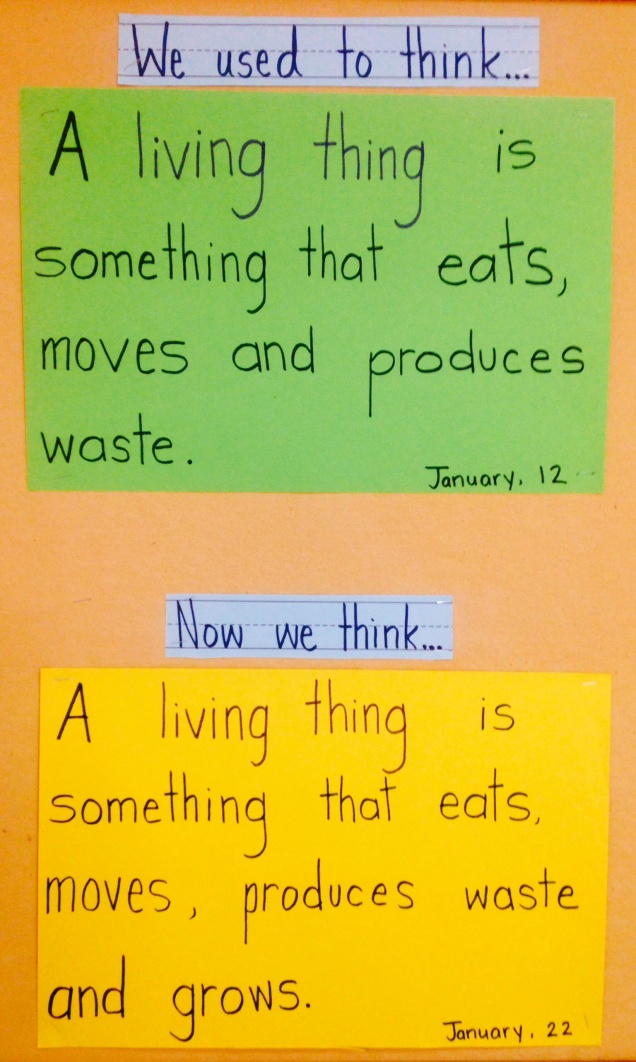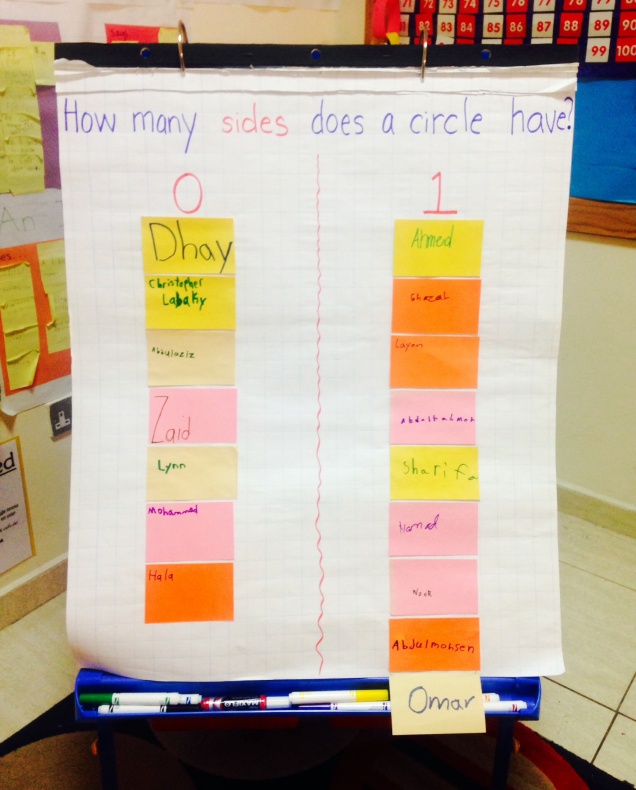A few weeks ago I posted a hodge-podge of resources about how to put inquiry into practice in the classroom. I have also shared these resources with the teaching teams I work with at school. The KG2 team really latched on to the suggestion of “maintaining neutrality” and many of them decided to test out that strategy in their classrooms. We were all blown away by the results! Here are two epic battles that challenged our five-year-olds to think, explain, reason, inquire, defend and in the end, change their own thinking (and the thinking of the adults in their lives too!)
Battle #1 – Is a Car a Living Thing?
During the course of a unit on, “How Living Things Depend on Resources to Survive”, one KG2 class had created a collective definition that a living thing “is something that eats, moves and produces waste”. One day the class was having a discussion and a student said that a car was a living thing.
Here is the crucial moment. The way the teacher responds to this statement can take the learning down two very different paths.
Path #1 – The teacher weighs in and gives the students the answer. “Actually, a car is not a living thing.” And that’s the end of that road.
Path #2 – The teacher remains neutral and either asks more questions or turns it back to the students. Thus embarking down an unchartered – but potentially amazing- road!
Our KG2 teacher chose Path #2 (thankfully!). First she asked her student why he thought that. The student said “Because it can move forward and backwards and eats fuel and has waste come out of the pipe at the back”. The teacher then turned it back to the class to see who agreed and who had a different idea. Thus, sparking a passionate debate! Some students agreed. Some students disagreed. Some students compared it to other examples of living things to support their case. Some students suggested new criteria to define living things. Eventually – after a fascinating discussion among five-year-olds – the class arrived at the conclusion that, not only, is a car NOT a living thing, but that they needed to change their original definition of living things to include “something that grows”.

Battle #2 – How Many Sides Does a Circle Have?
A different KG 2 class had been inquiring into shapes and the properties of shapes. They discovered that a square has four sides, a triangle has three sides… and then they looked at a picture of a circle. One student asked “How many sides does a circle have?”. The teacher was unsure about the answer, so she brought it up at a team meeting. We – as eight, grown-up, educated women with multiple degrees – could not agree on an answer. So we decided that if it was worth it for us to discuss, it was worth it for the students to discuss as well. So the teacher decided to stay neutral and see where her class would take her. Here are some quotes from her class debate:
“I think a circle has zero sides because a side has to be a straight line.”
“But it is a line, just a line that someone has bent to connect all the way around. If you made it straight there would be one side”
“I think it has zero sides because a side has to be between two vertices.”
“I think it has one side because a side it was keeps the insides from mixing with the outside.”
From here the class decided to go out into the school community and gather some data from more “experienced” mathematicians (aka high school math students). They also decided to ask their parents at home that evening. They decided as a class that since no one could agree on this matter, they would see which answer most people agreed with and they would use that as their answer.
How different this learning experience would have been if the teacher would have answered the original question, “How many sides does a circle have?”
Our KG2 team was loving the power of staying neutral! They were seeing their students engage in deep thinking, developing debating skills, collecting data, refining definitions, defending a stance – it was learning at its finest!
So what are the tricks for staying neutral? Here are some of their tips:
- Ask probing questions: When a student states their initial answer, at first it can sound way off the mark (e.g. That a car is a living thing). But if they are probed to explain their thinking, often fascinating connections, ideas and misconceptions are brought to light. Our three favourite probing questions are:
Why do you think that?
How do you know?
What makes you say that?
- Turn it back to the students: Once you have given the student a chance to explain their thinking, turn it back on the rest of the students in the class. This is where you can often start a great debate. It can be as simple as “What do you guys think?” or as structured as “Does anyone agree/disagree/have a different idea”.
- Don’t be afraid of wrong answers: At first, some of our teachers were uncomfortable not correcting their students’ misconceptions right away. They soon learned that it was more powerful to have the students realize their own misconceptions and change their own thinking, than for the teacher to simply tell them the answer.
- Be neutral about the answer but still help to guide the learning: Being neutral does not mean doing nothing. The teacher has the very important role of figuring out how to help the students arrive at the answer. For younger students, that could mean planning an experiment, suggesting to go ask “experts” in the school or in the community, or finding a book or video to share with the class. For older students, that could mean turning it back to them. “How can we find out?” “Who can we ask?” “Where can we learn more about this?”
- De-value the answer & Re-value the learning: At the end of the day, would you rather have a five-year-old who can repeat that a circle has x number of sides because their teacher told them so… or a five-year-old who can reason, argue, collect and analyze data, make conclusions and reflect on their own thinking? Easy answer.
The trickiest part of all, is noticing these opportunities when they pop up. So the next time you have a student who shares a wrong answer or a misconception with you, resist the urge to correct them and give them the answer. Remain neutral and see where it takes you!

Hello,
The PYP development team manages the SharingPYP blog, and posts articles about practice in the PYP that are written by insightful educators and experts. Our attention was drawn to this particular article of yours; we are interested in posting it on our blog.
If you would like to share this article with the PYP community, please email us. Hopefully you can see our email address on this comment. If not, let us know.
Thank you for your attention.
PYP development team
LikeLiked by 1 person
Hello,
I would be honoured to share this post with the PYP community. You can email me at taryn.bondclegg@ais-kuwait.org and let me know what I can do to help this happen.
Thanks!
Taryn
LikeLiked by 1 person
Taryn, I’d like to ask you about being a PYP Coordinator. It would be great if you could e-mail or send a message @MrLynnd on Twitter. Thanks.
LikeLike
I’ve had to come back to re-reading this post a few times this year. For me, remaining neutral is not as easy of a skill as it sounds or looks because we are so used to giving answers to questions in everyday life. I often catch myself biting my tongue and thinking over about how I should reply to my students questions or answers. I guess it will become more automatic with time but I am still working on this!
LikeLike